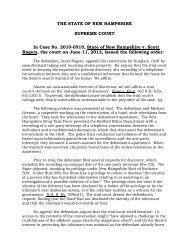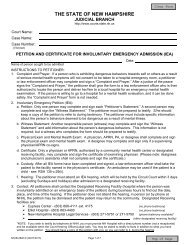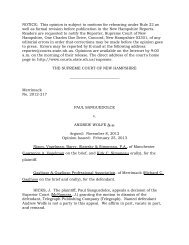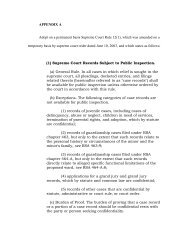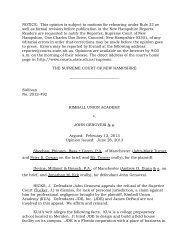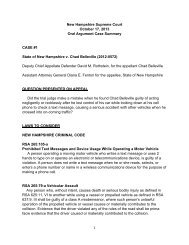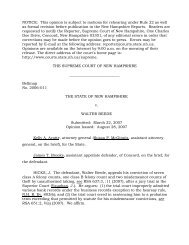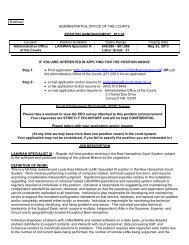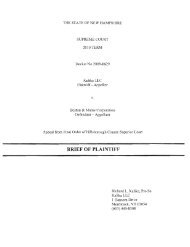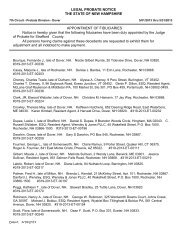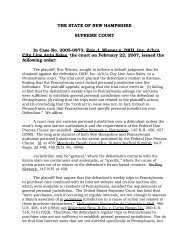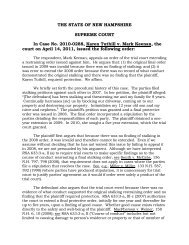NOTICE: This opinion is subject to motions for rehearing under Rule ...
NOTICE: This opinion is subject to motions for rehearing under Rule ...
NOTICE: This opinion is subject to motions for rehearing under Rule ...
Create successful ePaper yourself
Turn your PDF publications into a flip-book with our unique Google optimized e-Paper software.
<strong>NOTICE</strong>: <strong>Th<strong>is</strong></strong> <strong>opinion</strong> <strong>is</strong> <strong>subject</strong> <strong>to</strong> <strong>motions</strong> <strong>for</strong> <strong>rehearing</strong> <strong>under</strong> <strong>Rule</strong> 22 as<br />
well as <strong>for</strong>mal rev<strong>is</strong>ion be<strong>for</strong>e publication in the New Hampshire Reports.<br />
Readers are requested <strong>to</strong> notify the Reporter, Supreme Court of New<br />
Hampshire, One Charles Doe Drive, Concord, New Hampshire 03301, of any<br />
edi<strong>to</strong>rial errors in order that corrections may be made be<strong>for</strong>e the <strong>opinion</strong> goes<br />
<strong>to</strong> press. Errors may be reported by E-mail at the following address:<br />
reporter@courts.state.nh.us. Opinions are available on the Internet by 9:00<br />
a.m. on the morning of their release. The direct address of the court's home<br />
page <strong>is</strong>: http://www.courts.state.nh.us/supreme.<br />
Rockingham<br />
No. 2009-689<br />
THE SUPREME COURT OF NEW HAMPSHIRE<br />
___________________________<br />
STEPHEN BRUNELLE & a.<br />
v.<br />
BANK OF NEW YORK MELLON & a.<br />
Submitted: June 23, 2010<br />
Opinion Issued: Oc<strong>to</strong>ber 27, 2010<br />
Stephen and Ellen Brunelle, pro se, by brief.<br />
Sulloway & Holl<strong>is</strong>, P.L.L.C., of Concord (Derek D. Lick on the brief), <strong>for</strong><br />
defendant Bank of New York Mellon.<br />
BRODERICK, C.J. The plaintiffs, Stephen and Ellen Brunelle, appeal an<br />
order of the Trial Court (McHugh, J.) authorizing the defendants, Bank of New<br />
York Mellon; Novastar Mortgage, Inc.; Harmon Law Offices, P.C.; and Saxon<br />
Mortgage Services, Inc., <strong>to</strong> <strong>for</strong>eclose on the plaintiffs’ property if they fail <strong>to</strong><br />
repay funds required <strong>to</strong> allow resc<strong>is</strong>sion of the mortgage contract. They argue<br />
that the trial court erred in modifying their resc<strong>is</strong>sion rights <strong>under</strong> the Truth in<br />
Lending Act (“the Act”), see 15 U.S.C.A. §§ 1601 et seq. (West 2009). We affirm.<br />
The following facts appear in the record. The plaintiffs obtained a loan<br />
<strong>for</strong> $346,500.00 from Novastar Mortgage, Inc. (Novastar) in August 2005 <strong>for</strong>
property located at 7 Crane Crossing Road in New<strong>to</strong>n, New Hampshire. Of the<br />
loan proceeds, $231,190.74 was paid <strong>to</strong> Novastar <strong>to</strong> pay off a preex<strong>is</strong>ting<br />
mortgage and $109,371.55 was paid directly <strong>to</strong> the plaintiffs in cash.<br />
Defendants Saxon Mortgage Services, Inc. and Bank of New York Mellon<br />
(hereinafter “defendants”) were subsequently assigned Novastar’s rights <strong>under</strong><br />
the note. The defendants initiated <strong>for</strong>eclosure proceedings against the<br />
plaintiffs in early July 2008. The plaintiffs then filed an equity proceeding<br />
seeking <strong>to</strong> enjoin the <strong>for</strong>eclosure.<br />
By letter dated July 14, 2008, the plaintiffs wrote <strong>to</strong> the Harmon Law<br />
Offices in New<strong>to</strong>n, Massachusetts, stating in part: “We are writing <strong>to</strong> officially<br />
rescind or cancel the loan referenced above, dated August 17 th 2005 by<br />
Novastar Mortgage Inc. Upon examining our notice of right <strong>to</strong> cancel, we<br />
d<strong>is</strong>covered that there was no address <strong>for</strong> Novastar Mortgage, which <strong>is</strong> in<br />
violation of regulation Z of the [Act].” The defendants agreed <strong>to</strong> <strong>for</strong>ego<br />
<strong>for</strong>eclosure and <strong>to</strong> allow the plaintiffs <strong>to</strong> rescind; <strong>under</strong> the defendants’<br />
resc<strong>is</strong>sion proposal, the plaintiffs would repay the cash they received at closing,<br />
minus finance charges and closing costs. By letter dated September 8, 2008,<br />
the plaintiffs rejected th<strong>is</strong> proposal, arguing that they were not liable <strong>for</strong><br />
repayment of any cash received at the closing, and were also entitled <strong>to</strong> a cash<br />
payment of $67,260.<br />
When no agreement concerning resc<strong>is</strong>sion was reached, trial was held on<br />
the original equity petition filed by the plaintiffs. We note that the appellate<br />
record does not contain a copy of that petition. The trial court found, however,<br />
that the plaintiffs “ra<strong>is</strong>ed in their pleadings a series of ‘technical defenses.’”<br />
The court was asked <strong>to</strong> enjoin the <strong>for</strong>eclosure because the lender did not have<br />
the original note, the annual percentage rate d<strong>is</strong>closed on the truth-in-lending<br />
d<strong>is</strong>closure was incorrect, and the notice of the right <strong>to</strong> cancel provided <strong>to</strong> the<br />
plaintiffs at the closing on the loan did not contain the address of the lender as<br />
required <strong>under</strong> Regulation Z of the Act.<br />
The court found that the only defense with any legal merit was the fact<br />
that the Notice of Right <strong>to</strong> Cancel document given <strong>to</strong> the plaintiffs at closing<br />
included only the name of the lender and not the lender’s address. The court<br />
further found, however, that th<strong>is</strong> om<strong>is</strong>sion did not prejudice the plaintiffs<br />
because at the time of the closing they worked <strong>for</strong> the mortgage holder and<br />
obviously knew its address. The trial court concluded that “there <strong>is</strong> no legal or<br />
equitable bas<strong>is</strong> <strong>for</strong> the continued prohibition against the defendants from<br />
<strong>for</strong>eclosing on the mortgage.” The trial court then stated: “Although th<strong>is</strong> would<br />
appear <strong>to</strong> be an exerc<strong>is</strong>e in futility, so as <strong>to</strong> give the plaintiffs one last<br />
opportunity <strong>to</strong> implement their right of resc<strong>is</strong>sion, the Court orders that the<br />
defendants notify the plaintiffs within thirty days as <strong>to</strong> exactly how much<br />
monies they would have <strong>to</strong> pay <strong>for</strong> resc<strong>is</strong>sion <strong>to</strong> take place.” The plaintiffs were<br />
2
then allowed thirty days from receipt of the calculation of the amount due <strong>to</strong><br />
pay that amount <strong>to</strong> the defendants by cash or certified check.<br />
On appeal, the plaintiffs argue that the trial court erred in finding that<br />
the defendants were entitled <strong>to</strong> proceed with <strong>for</strong>eclosure because even though<br />
the defendants conceded at trial that they violated the Act, they failed <strong>to</strong><br />
per<strong>for</strong>m their resc<strong>is</strong>sion duties. Given th<strong>is</strong> failure, the plaintiffs argue that<br />
their duty <strong>to</strong> tender never arose and that resc<strong>is</strong>sion <strong>is</strong> a complete defense <strong>to</strong><br />
<strong>for</strong>eclosure of the property. Because the <strong>is</strong>sues be<strong>for</strong>e us present only<br />
questions of law, we review them de novo. See Coco v. Jaskunas, 159 N.H.<br />
515, 518 (2009).<br />
The Act provides, in pertinent part:<br />
When an obligor exerc<strong>is</strong>es h<strong>is</strong> right <strong>to</strong> rescind <strong>under</strong><br />
subsection (a) of th<strong>is</strong> section, he <strong>is</strong> not liable <strong>for</strong> any finance or<br />
other charge, and any security interest given by the obligor,<br />
including any such interest ar<strong>is</strong>ing by operation of law, becomes<br />
void upon such a resc<strong>is</strong>sion. Within 20 days after receipt of a<br />
notice of resc<strong>is</strong>sion, the credi<strong>to</strong>r shall return <strong>to</strong> the obligor any<br />
money or property given as earnest money, downpayment, or<br />
otherw<strong>is</strong>e, and shall take any action necessary or appropriate <strong>to</strong><br />
reflect the termination of any security interest created <strong>under</strong> the<br />
transaction. If the credi<strong>to</strong>r has delivered any property <strong>to</strong> the<br />
obligor, the obligor may retain possession of it. Upon the<br />
per<strong>for</strong>mance of the credi<strong>to</strong>r’s obligations <strong>under</strong> th<strong>is</strong> section, the<br />
obligor shall tender the property <strong>to</strong> the credi<strong>to</strong>r, except that if<br />
return of the property in kind would be impracticable or<br />
inequitable, the obligor shall tender its reasonable value. Tender<br />
shall be made at the location of the property or at the residence of<br />
the obligor, at the option of the obligor. If the credi<strong>to</strong>r does not<br />
take possession of the property within 20 days after tender by the<br />
obligor, ownership of the property vests in the obligor without<br />
obligation on h<strong>is</strong> part <strong>to</strong> pay <strong>for</strong> it. The procedures prescribed by<br />
th<strong>is</strong> subsection shall apply except when otherw<strong>is</strong>e ordered by a<br />
court.<br />
15 U.S.C.A. § 1635(b).<br />
Regulation Z of the Truth in Lending Regulations, with respect <strong>to</strong> the<br />
effects of resc<strong>is</strong>sion, provides:<br />
3
(d) Effects of resc<strong>is</strong>sion.<br />
(1) When a consumer rescinds a transaction, the security<br />
interest giving r<strong>is</strong>e <strong>to</strong> the right of resc<strong>is</strong>sion becomes void and the<br />
consumer shall not be liable <strong>for</strong> any amount, including any finance<br />
charge.<br />
(2) Within 20 calendar days after receipt of a notice of<br />
resc<strong>is</strong>sion, the credi<strong>to</strong>r shall return any money or property that<br />
has been given <strong>to</strong> anyone in connection with the transaction and<br />
shall take any action necessary <strong>to</strong> reflect the termination of the<br />
security interest.<br />
(3) If the credi<strong>to</strong>r has delivered any money or property, the<br />
consumer may retain possession until the credi<strong>to</strong>r has met its<br />
obligation <strong>under</strong> paragraph (d)(2) of th<strong>is</strong> section. When the<br />
credi<strong>to</strong>r has complied with that paragraph, the consumer shall<br />
tender the money or property <strong>to</strong> the credi<strong>to</strong>r or, where the latter<br />
would be impracticable or inequitable, tender its reasonable value.<br />
At the consumer’s option, tender of property may be made at the<br />
location of the property or at the consumer’s residence. Tender of<br />
money must be made at the credi<strong>to</strong>r’s designated place of<br />
business. If the credi<strong>to</strong>r does not take possession of the money or<br />
property within 20 calendar days after the consumer’s tender, the<br />
consumer may keep it without further obligation.<br />
(4) The procedures outlined in paragraphs (d)(2) and (3) of th<strong>is</strong><br />
section may be modified by court order.<br />
12 C.F.R. § 226.23(d) (2010).<br />
The plaintiffs first assert that <strong>under</strong> the Act and Regulation Z, the<br />
defendants’ mortgage au<strong>to</strong>matically became void, and their right <strong>to</strong> <strong>for</strong>eclose<br />
was lost, when the plaintiffs sent the defendants their notice of resc<strong>is</strong>sion.<br />
However, neither the Act nor Regulation Z establ<strong>is</strong>hes that a borrower’s mere<br />
assertion of the right of resc<strong>is</strong>sion has the au<strong>to</strong>matic effect of voiding the<br />
contract. Large v. Conseco Finance Servicing Corp., 292 F.3d 49, 54 (1st Cir.<br />
2002). Rather, the lender’s security interest becomes void only when the right<br />
<strong>to</strong> rescind <strong>is</strong> available, either by agreement between the borrower and lender,<br />
or by court order. See id. at 54-56.<br />
The plaintiffs next contend that the defendants were required <strong>to</strong> file a<br />
declara<strong>to</strong>ry judgment action within twenty days after receiving the notice of<br />
resc<strong>is</strong>sion if they d<strong>is</strong>puted it. In support of th<strong>is</strong> argument, the plaintiffs cite<br />
only section 1635(b) of the Act. Nothing in the plain language of section<br />
4
1635(b), however, required the defendants <strong>to</strong> file a declara<strong>to</strong>ry judgment action<br />
within twenty days in order <strong>to</strong> d<strong>is</strong>pute the notice of resc<strong>is</strong>sion, and we reject<br />
the plaintiffs’ position that the defendants’ failure <strong>to</strong> do so acts as the<br />
equivalent of an agreement that the right <strong>to</strong> rescind was available. See id. at<br />
54; cf. State v. Chr<strong>is</strong>icos, 159 N.H. 405, 407 (2009) (supreme court will not add<br />
language <strong>to</strong> statute that leg<strong>is</strong>lature did not see fit <strong>to</strong> include).<br />
In th<strong>is</strong> case, the defendants d<strong>is</strong>puted the plaintiffs’ claimed right <strong>to</strong><br />
rescind the full amount of the loan, and the court conditioned the plaintiffs’<br />
resc<strong>is</strong>sion rights upon tender of the loan proceeds. There<strong>for</strong>e, we reject the<br />
plaintiffs’ claim that the defendants lost their <strong>for</strong>eclosure remedy when the<br />
plaintiffs sent their notice of resc<strong>is</strong>sion. Absent compliance with the terms of<br />
the court’s order, the plaintiffs had advanced only a claim seeking resc<strong>is</strong>sion.<br />
See Large, 292 F.3d at 55.<br />
The plaintiffs next challenge the trial court’s authority <strong>to</strong> condition their<br />
right <strong>to</strong> rescind, construing the Act and Regulation Z as requiring the<br />
unconditional release of the mortgage regardless of the plaintiffs’ ability <strong>to</strong><br />
tender the balance due on the loan. In essence, they claim the right <strong>to</strong> a<br />
substantial windfall without any further obligation on their part. “<strong>Th<strong>is</strong></strong><br />
construction not only offends traditional notions of equity, but m<strong>is</strong>interprets<br />
the procedural requirements of § 1635(b).” American Mortg. Network, Inc. v.<br />
Shel<strong>to</strong>n, 486 F.3d 815, 820 (4th Cir. 2007).<br />
Courts have an inherent power <strong>to</strong> condition resc<strong>is</strong>sion <strong>under</strong> proper<br />
circumstances. In re Lynch, 170 B.R. 26, 29 (Bankr. D.N.H. 1994). The<br />
resc<strong>is</strong>sion process <strong>under</strong> the Act has two goals – <strong>to</strong> place the consumer in a<br />
much stronger bargaining position, and <strong>to</strong> return the parties most nearly <strong>to</strong> the<br />
position they held prior <strong>to</strong> entering in<strong>to</strong> the transaction. Id. The last sentence<br />
of section 1635(b), which was added by Congress in 1980, reflects th<strong>is</strong> second<br />
goal, and gives courts d<strong>is</strong>cretion <strong>to</strong> modify the procedures in the Act, including<br />
by “conditioning resc<strong>is</strong>sions upon the deb<strong>to</strong>r’s prior return of the principal.”<br />
Id. at 29 (quotation omitted); see also 12 C.F.R. § 226.23(d)(4).<br />
In th<strong>is</strong> case, the plaintiffs contend that the trial court failed <strong>to</strong> make<br />
findings <strong>to</strong> support equitable modification. We d<strong>is</strong>agree. The trial court found<br />
that the deficiency in the documents that led <strong>to</strong> the notice of resc<strong>is</strong>sion – the<br />
absence of the lender’s address – did not prejudice the plaintiffs since they<br />
worked <strong>for</strong> the lender and obviously knew its address. “On the facts of the<br />
instant case, Congress could not have intended that the security interest of the<br />
defendant[s] be voided when the plaintiffs were unable <strong>to</strong> tender payment <strong>to</strong> it.”<br />
Lynch, 170 B.R. at 29. Accordingly, we conclude that the trial court acted<br />
within its d<strong>is</strong>cretion by placing conditions upon resc<strong>is</strong>sion, and did not err by<br />
otherw<strong>is</strong>e declining <strong>to</strong> void the defendants’ mortgage.<br />
5
Issues ra<strong>is</strong>ed in the plaintiffs’ notice of appeal but not addressed in their<br />
brief are deemed waived. See State v. Blackmer, 149 N.H. 47, 49 (2003).<br />
6<br />
Affirmed.<br />
DALIANIS, DUGGAN and HICKS, JJ., concurred.



